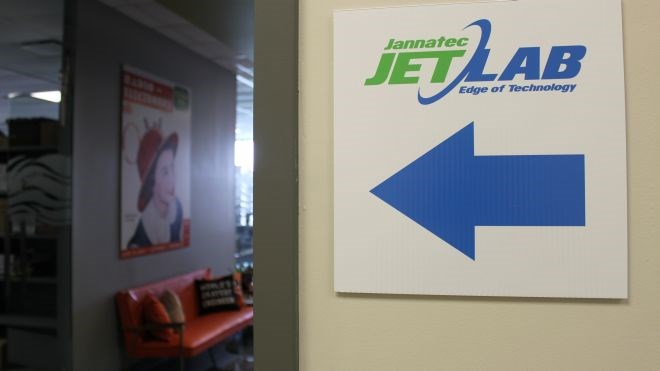Jannatec Technologies president Wayne Ablitt had been having difficulty attracting the best and brightest engineering minds to his Sudbury firm, and so he set his eye to the offices of some of the most iconic tech companies — think Google or Facebook — for inspiration.
“Over a period of time, we started to look at other businesses and why they were successful in getting some of these star candidates, because a company is only as good as the employees that you have,” Ablitt said.
Welcome to Sudbury’s JETLab — an acronym for Jannatec Edge of Technology — anything but a traditional engineering department.
The new, 4,500-square-foot office, located in the Northern Centre for Advanced Technology (NORCAT), has been designed as a relaxed, informal work space aimed at encouraging free thought and creativity. Ablitt hopes it will serve as a recruitment and retention tool to bring the most qualified engineers and tech designers on board.
“You spend basically half your time of your life when you’re awake at your job, so we want to build a healthier environment for our employees to work in, and we want them to feel that they’re coming to something very positive and something that’s moving forward,” said Ablitt, who co-founded Jannatec, which specializes in communications technologies for underground mining.
Vetting candidates through traditional routes had proven frustrating; job postings had turned up few quality candidates, and of those that did apply, few stayed for a job, Ablitt said.
So Ablitt and his management team made a decision that might seem surprising in the current mining downturn: a $350,000 investment in the new space.
Designed by Terry Vendetti Interiors, the JETLab is a bright, open space with lots of natural light. There are desks and a boardroom, but there are also couches, a lounge area and a kitchen, all against a funky backdrop of glass walls, vibrant primary colours and wall tiles of synthetic grass.
Fourteen employees will move into the new space, and there is room to add between six and eight more.
Yet the changes are more than just cosmetic.
Jannatec’s research and development manager, Jason Buie, said that moving the R&D and service departments into a purpose-built space reduces interruptions and distractions and lets the company’s engineers devote their attention to innovation.
“The lab and the work area there is 100 per cent dedicated to developing technology,” Buie said. “That’s all we’re doing over there.”
New equipment will allow the engineers to test the company’s communications products — for example, a new chamber being designed in conjunction with Laurentian University’s Centre for Research in Occupational Safety and Health (CROSH) will allow the company to test for human factors.
It will play a central role in helping Jannatec advance its wearable communications devices as part of the Ultra-Deep Mining Network (UDMN).
“We’re trying to create an environment that’s fun to come to work,” Buie said. “It’s conducive to creativity and it’s conducive to free thought with technology in mind.”
Ablitt recognizes some will think him unwise for making such a large investment during a downturn in the industry, and he emphasizes that Jannatec has cut its expenses in other areas of the company. But he’s also a firm believer in not losing sight of the company’s long-term goals.
Jannatec has committed to not cut its R&D and sales departments, and the company has actually expanded with a new office in Saskatchewan. It’s also developing a suite of new products that it plans to market to the construction, policing and fire service industries.
“It was either we wait for an upturn, which in the mining industry could take another year or two, or we start now,” Ablitt said.
It might take two to three years before he’s able gauge the success of his experiment, but he believes it will pay off in the long term.
“When employees see you reinvesting, it gives them confidence,” Ablitt said. “The payback is, if we gain one great engineer that we can get to come here because he likes that facility, he can easily pay for himself.”




